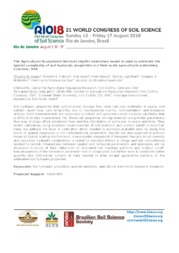The Agricultural Ecosystems Services (AgES) watershed model is used to estimate the spatial complexity of soil hydraulic properties in a field-scale agricultural watershed, Colorado, USA.
The Agricultural Ecosystems Services (AgES) watershed model is used to estimate the spatial complexity of soil hydraulic properties in a field-scale agricultural watershed, Colorado, USA.
Autoria: GREEN, T. R.; ERSKINE, R. H; DAVID, O.; KIPKA, H.; LIGHTHART, N.; McMASTER, G. S.; CRUZ, P. P. N. da; FIGUEIREDO, R. de O.
Resumo: Soil hydraulic properties that control water storage flow rates can vary markedly in space, and surface layers may vary temporally due to management events, reconsolidation and biological activity. Field measurements are expensive to collect and generally reveal complex variability that is difficult to fully characterize. Yet, these soil properties are represented using model parameters that may strongly affect simulated flows and the distribution of soil water in space and time. Thus model calibration using available measurements of soil moisture and surface runoff is essential. Here, we address the level of calibration detail needed to estimate available data by using five levels of spatial complexity in the calibrated soil parameters. Results are also explored to address issues of spatial scaling. Furthermore, a new model component of temporal changes in soil porosity and saturated hydraulic conductivity is tested to simulate effects of tillage and soil consolidation related to rainfall. Interactions between spatial and temporal parameters and processes will be discussed in terms of their influences on simulated soil moisture patterns and surface runoff. Non-uniqueness of the estimated parameter sets is recognized, but further work is needed to better quantify the information content of data needed to infer unique space-time patterns of the estimated soil hydraulic properties.
Ano de publicação: 2018
Tipo de publicação: Resumo em anais e proceedings
Unidade: Embrapa Meio Ambiente
Palavras-chave: Agricultural watershed, Spatial variability, Temporal dynamics, soil hydraulic properties
Observações
1 - Por padrão são exibidas publicações dos últimos 20 anos. Para encontrar publicações mais antigas, configure o filtro ano de publicação, colocando o ano a partir do qual você deseja encontrar publicações. O filtro está na coluna da esquerda na busca acima.
2 - Para ler algumas publicações da Embrapa (apenas as que estão em formato ePub), é necessário ter, no celular ou computador, um desses softwares gratuitos. Sistemas Android: Google Play Livros; IOS: iBooks; Windows e Linux: software Calibre.
Acesse outras publicações
Acesse a Base de Dados da Pesquisa Agropecuária (BDPA) para consultar o acervo completo das bibliotecas da Embrapa.

